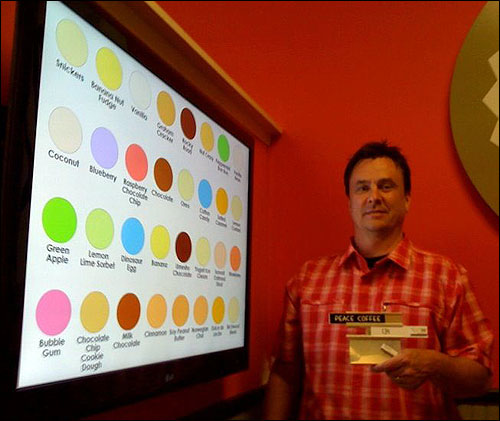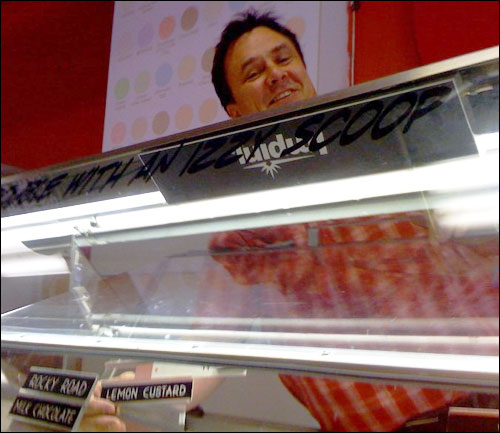Izzy’s Ice Cream Café is no ordinary ice cream parlor. The 10-year-old shop, located in Saint Paul, Minn., prepares small batches of artisan varieties—with such names as Salted Caramel and Summit Oatmeal Stout (made with a locally brewed beer)—as well as more standard fare, like vanilla or bubble gum. And it recently launched an RFID system to help inform customers about its ever-changing menu of flavors—with updates available in near-real time—as well as to provide a quick and easy way to keep the store’s signage up to date.
“I’d heard lots of stuff about RFID,” says Jeff Sommers, who runs Izzy’s along with his wife, Lara Hammel. “I had read a story about lawyers using RFID to track case files, and realized that the technology might work for us, too.”

Frozen dairy treats and paper files are worlds apart, however, when it comes to the performance of the passive, low-cost RFID tags that Sommers wanted to use. So he partnered with AbeTech, an RFID systems integrator based in the nearby city of Rogers, in order to design a system that would function reliably despite the moist and metal-rich environment inside Izzy’s two refrigerated ice cream display cases (also known as dipping cabinets). Moisture and metal materials can interfere with the RF signals transmitted between the tags and the reader.
Izzy’s fastened a Confidex Steelwave Micro EPC Gen 2 ultrahigh-frequency (UHF) RFID tag to the back side of each of the hard plastic labels it uses to identify the flavors of ice cream it sells. Each tag is encoded with a unique ID number associated with the specific flavor noted on the label to which it is adhered. When an employee removes an empty ice cream container from the display case and replaces it with a new flavor, he or she also replaces the label. These labels are positioned onto aluminum brackets that Sommers had custom-made for the RFID system. The brackets enable a buffer of air between the tag and the cabinet’s metal frame, which prevents RF interference when the reader inside the case transmits its signal.
A trickier part of the design, Sommers says, involved getting the reader antennas correctly positioned within the dipping cabinets. The antennas were initially mounted on the cabinets’ doors, but when the doors were open, this caused RF interference. AbeTech then tried several other configurations, including placing the antennas at the bottom of the display cases, below the ice cream. However, he says, nothing worked. Eventually, the company was able to suspend the antennas from the top inside of the case, and this proved effective.
In the final configuration, Sommers says, the case was fitted with four antennas, manufactured by Impinj, and powered by a single Impinj Speedway reader mounted under the case.
From a business point of view, Sommers says he designed the system to accomplish two goals: letting customers know what was on offer without their having to physically visit the ice cream parlor, and finding a fast and easy method for updating the available-flavor signs within the store.
Over the years, Sommers explains, Izzy’s has developed a loyal base of customers, many of whom want to know when their favorite flavor becomes available. And since some of the more exotic flavors are seldom made—and are produced in small batches—the window during which these flavors are available is often rather small. To that end, he and his staff maintained a list of patrons who had asked to be notified when certain flavors are available, but sending e-mail alerts to those individuals proved to be a time burden. What’s more, these customers would sometimes arrive only to find that their favorite flavor was already sold out. With the RFID system, Sommers launched a special page on the company’s Web site that shows all available flavors, updated every three minutes. He also utilizes social media tools, such as Twitter and Facebook, to alert customers when a flavor becomes available.

Inside the store, two video monitors display the list of the flavors within the cases, updated every three seconds: One screen, located behind the counter, shows employees which flavors are in each case, while another, mounted on the wall, beams a similar list to customers.
With the hardware in place, the system was up and running—but a snag quickly emerged, Sommers notes. The antennas produced a read zone inside the ice cream display cases that did not quite cover 100 percent of the cases, which meant that not every tag was detected at all times. If a flavor’s tag was positioned just on the edge of the read field, that flavor would appear and disappear on the “current flavors” list multiple times each hour, because the reader would fail to capture it every time it scanned the case. To fix this problem, Sommers says, the software was tweaked so that it would always collect the 32 most recently detected flavors on the board. That way, even if only 31 tags are read in a single scan, the flavor corresponding to the unread tag should still appear on the list. Since approximately 20 scans are performed per second, and because the store displays are updated every three seconds, the company can now be assured that the list shown is reliably accurate.
While getting the system up and running was neither a painless nor cheap process—Sommers estimates he spent more than $30,000 on it—it has proven itself to be a great way for Izzy’s to improve its customer engagement, he says, while also deepening the customer loyalty it has cultivated over the years. Moreover, he adds, since the RFID system was launched in mid-May 2010, sales have risen compared with those for the same time period in previous years. Granted, Sommers admits, it is still too early to know for certain if the sales uptick is linked directly to the new technology, since weather and other factors can change from year to year, greatly influencing the business. Still, he feels confident that it has been a major factor.
It could be a long time, Sommers says, before he recoups his $30,000 investment, but if another ice cream shop wanted to deploy the RFID system he devised, he would be interested in licensing that system.
As for other potential RFID applications within the business—such as tracking the ice cream production process, or taking inventory of the finished ice cream stored inside Izzy’s walk-in freezers—Sommers says he has no plans at present. He currently employs bar-code technology to identify his stock. When a container of ice cream is made, the store prints a bar-coded ID number onto an adhesive label. That ID is associated with the flavor and date, and the label is attached to the container, which is then placed into the freezer. And that setup, he says, works just fine.

